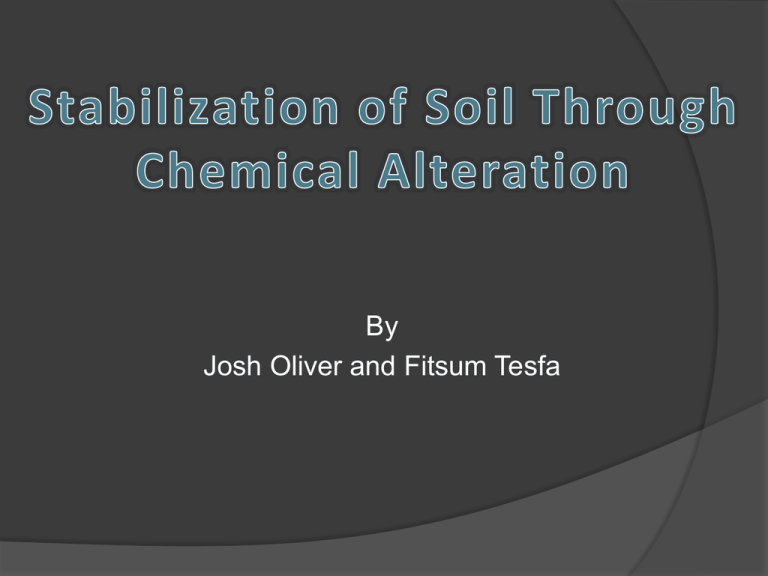Expansive soil - WordPress.com
advertisement

By Josh Oliver and Fitsum Tesfa Expansive soil Soil obtain in Plano, Texas First Step Oven dried for 24hrs at 160 degree The oven dried soil was crushed After soil was crushed it was then pulverized Classification of soil using mechanical analysis Sieve analysis was performed on soil for 10 to 15 min Depending on the particle size ,we concluded the ratio of gravel, sand, and clay and silt the soil contained Classification of Soil using mechanical analysis Hydrometer analysis, performed using the hydrometer bulb The main idea of this experiment was to determine particulates sizes that are smaller than 0.075mm in diameter Treatment of Soil Chemical additive were lime and cement Two different ratios were added to soil 3%lime, 3%cement 4% lime, 4%cement Dynamic & static compression These two types of compression are used in the preparation of soil samples for testing in the swell potential and unconfined compression test test swelling graph test One Swelling dimensional % swell vs time one dimensional swelling test time(min) %1D SWELL 8 control 7 h= 6 5 4 3 2 1 0 0.1 -1 0.1 0.5 1 2 5 15 30 60 120 1440 100801 treated 3%lime treated 4%lime control 3%cement 4%cement 0.983in d=2.495in w=139.05gm 0.097 0 0.102 0.508647 0.103 0.610376 0.106 0.915565 0.114 1.7294 0.125 2.848423 0.13 3.35707 0.135 3.865717 0.14 4.374364 0.163 6.71414 10 0.169 7.324517 100 1.008in d=2.498in w=138.24gm 1000 0.175 0 0.175 0 0.175 0 0.175 0 0.175 0 0.175 0 0.175 0 0.175 0 0.175 0 0.175 0 10000 100000 0.177 0.198413 Time (min) treated 1.026in3%lime & 3%cement d=2.500in w=137.29gm treated 0.299 4%lime 0 & 4%cement 0.299 0 0.299 0.299 0.299 0.299 0.299 0.299 0.299 0.299 0.299 0 0 0 0 0 0 0 0 0 Shrinkage testshrinkage graph Soil test for linear soil test for linear shrinkage control Linear deformation (%) 16 treated 3%lime 4% lime, 4% cement 3%cement 14 12 soil(gm) 200 8 length(mm) initial 200 45% 45% 45% 12.8 12.8 12.8 10.8 12 12.6 2 0.8 0.2 15.63 6.25 1.563 control 6 final length(mm) (mm) linear shrinkage strain % 2 control 0 4%cement 200 3% lime, 3% cement water 10 shrinks 4 treated 4%lime treated 3%lime & 3%cement treated 4%lime & 4%cement Soil samples for Unconfined Compression Test Soil sample stayed in moisture room at 100% humidity for 7days UCT is than ran on samples Unconfined Compression Test unconfined commpression test data soil strength(lb) F= 220 450 588 pressure(psi) P= 35.35 72.1 93.81 control treated 3%lime soil 3%cement treated 4%lime PRESSURE=FORCE/AREA 4%cement AREA=3.141 * DIAMETER^2/4 diameter(in) D= 2.815 2.819 2.825 height(in) H= 5.63 5.669 5.583 area(in)^2 A= 6.224 6.241 6.268 Unconfine Compression Test Pressure endured before failure pressure(psi) 100 80 60 40 20 0 control treated 3%lime & 3%cement treated 4%lime & 4%cement Unconfined Compression Test 600 500 Soil Strength (lb) 400 4%lime, 4%cement 300 3%lime,3%cement Control 200 100 0 0 10 20 30 40 50 60 70 80 Time (sec) 90 100 110 120 130 140 Conclusion Soil treated or chemically altered with a 4% lime-4% cement proved to be more stable as indicated by the test performed. The 3% lime-3% cement treatment increased stability but not substantially compared to the 4% ratios. Both treatments proved stronger and more stable than the control. This research proved that lime and cement additives improved the overall qualities and performance of the soil. Research in this field is proving invaluable to stabilization there by improving long term viability of structures. Acknowledgments I would like to extend a special thanks to Dr. Puppala, Aravind Pedarla, and Ranjan Rout for expertise and assistance rendered that provided me with invaluable experience also recognizing Dr. Yazdani, Dr. Daza, Dr. Weatherton, Minh Le, the University of Texas at Arlington Civil engineering Dept., University of Texas at Arlington and the National Science Foundation. Questions






